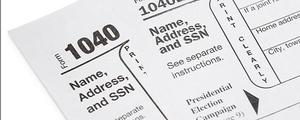WASHINGTON, D.C. -- Nearly half of Americans, 49%, believe middle-income people -- a group many Americans consider themselves part of -- pay too much in taxes, up from 42% a year ago and the highest Gallup has found since 1999. At the same time, the 42% who say middle-income Americans pay their "fair share" in taxes is down 11 percentage points from last year. This is also the first time since 2007 that a higher percentage of the public says middle-income Americans are paying too much rather than their fair share.
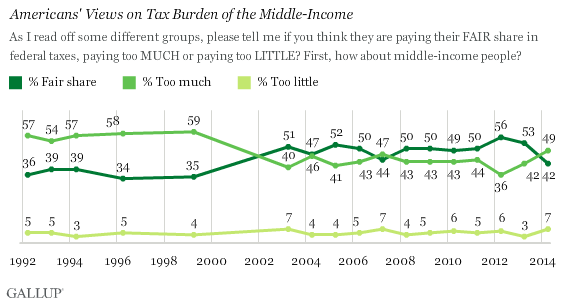
These results are from Gallup's annual Economy and Personal Finance poll, conducted April 3-6.
While the April 15 tax deadline may not be the most popular day on the nation's calendar, over the past decade, stable pluralities and sometimes majorities have said that middle-income Americans pay their fair share in taxes, rather than too much or too little. But the perception has grown since 2012 that middle-income Americans pay too much in taxes; this comes as income taxes increase for the first time in 20 years, though mainly for the top earners. President Barack Obama and Congress allowed the Bush tax cuts on the marginal rates for the highest income earners to expire last year, which increased the tax rate for 2013 income from 35.0% to 39.6%. Other taxes, such as capital gains taxes, have also increased, and the bill is now coming due for many taxpayers.
Though the bulk of the higher tax rates affect those in the top income bracket -- $400,000 for individuals and $450,000 for married couples -- there has not been a noticeable climb in the proportion of Americans who believe upper-income people pay too much. That figure stands at 13% today, essentially unchanged from 11% last year. A robust majority, 61%, believe that upper-income people pay too little, while about a quarter believe they pay their fair share.
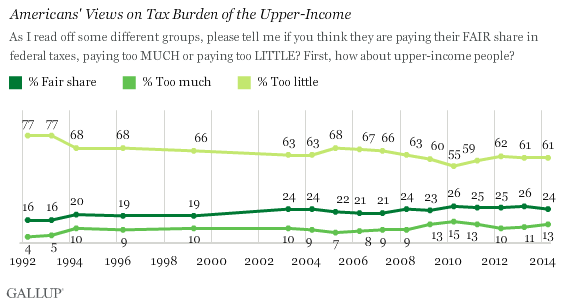
At the other end of the income spectrum, a plurality of Americans, 41%, say lower-income people pay too much in taxes. A third of Americans say the lower-income pay their fair share, while 23% say they pay too little, one point off the record high from 2012.
More broadly, Gallup's two-decade trend shows a clear increase in the percentage of Americans who believe the lower-income pay too little in taxes. The figure varied from 8% to 12% throughout the 1990s and the first half of the 2000s. It then jumped to between 13% and 17% in the late 2000s, and has consistently been near or above 20% since 2010.
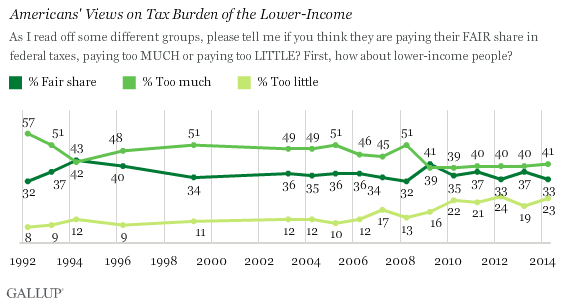
Republicans More Likely Than Democrats to Say Lower-Income Pay Too Little
Tax rates -- how high they are and who should pay them -- are a central debate in American politics. Not surprisingly, self-identified Republicans and Democrats disagree on how Uncle Sam treats the upper- and lower-income groups. A plurality of Republicans (40%) believe lower-income individuals pay too little in federal income taxes, far higher than the 22% of independents and 11% of Democrats who think so.
Republicans are also much less likely than Democrats or independents to believe upper-income people are paying too little (45%), though still a plurality think this. By contrast, 61% of independents and 76% of Democrats believe upper-income Americans pay too little.
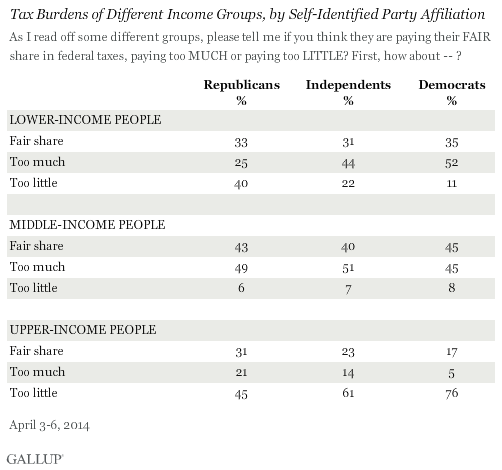
One area of accord is with respect to middle-income people. Republicans (49%), independents (51%), and Democrats (45%) are about equally as likely to say middle-income earners pay too much in taxes -- a reminder of why politicians design tax-cut proposals to help the middle class more than any other group.
Two-Thirds of Americans Believe Corporations Pay Too Little in Taxes
As is typical, most Americans say corporations pay too little in taxes (66%). Fewer than one in 10 say corporations pay too much (8%). Despite this broad consensus, prominent Republicans and Democrats, including Obama and Republican Dave Camp, chairman of the tax-writing House Ways and Means Committee, have offered separate proposals to reduce the corporate tax rate.
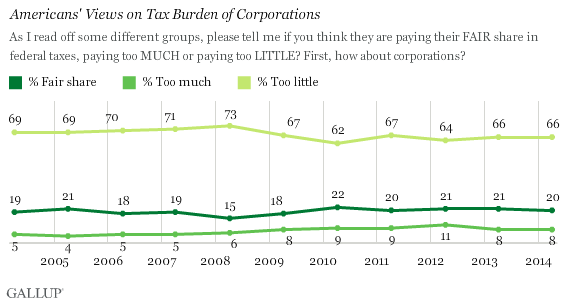
Implications
More Americans now think the middle class is paying too much in taxes than at any time since the 2001 tax cuts. The reasons for the shift are not obvious. Although some Americans' federal income tax rates have increased in the past year, those increases were largely confined to the highest earners. The payroll tax increase, taking effect in January 2013 paychecks, may have influenced Americans' perceptions of their income taxes, though those effects would have been first felt last year. News reports about higher tax rates for some taxpayers may have influenced Americans' perceptions of middle-income taxes, or perhaps the ongoing debate between Obama and Republicans about efforts to reduce income equality are having an effect. Also, many Americans consider themselves middle class, even if they fall on the higher end of the income distribution, and this could help explain the spike.
An interesting trend is the growing proportion of Americans who believe lower-income individuals pay too little. This comes after a presidential election in which some attention was paid to the so-called "47%" who pay no income tax because of their low income levels. While this issue caused some trouble for Republican presidential nominee Mitt Romney, who spoke dismissively of this segment of the population in a secretly recorded video, it appears that an expanding number of Americans do believe the lowest-income earners should pay more in taxes.
Survey Methods
Results for this Gallup poll are based on telephone interviews conducted April 3-6, 2014, on the Gallup Daily tracking survey, with a random sample of 1,026 adults, aged 18 and older, living in all 50 U.S. states and the District of Columbia.
For results based on the total sample of national adults, the margin of sampling error is ±4 percentage points at the 95% confidence level.
Interviews are conducted with respondents on landline telephones and cellular phones, with interviews conducted in Spanish for respondents who are primarily Spanish-speaking. Each sample of national adults includes a minimum quota of 50% cellphone respondents and 50% landline respondents, with additional minimum quotas by time zone within region. Landline and cellular telephone numbers are selected using random-digit-dial methods. Landline respondents are chosen at random within each household on the basis of which member had the most recent birthday.
Samples are weighted to correct for unequal selection probability, nonresponse, and double coverage of landline and cell users in the two sampling frames. They are also weighted to match the national demographics of gender, age, race, Hispanic ethnicity, education, region, population density, and phone status (cellphone only/landline only/both, and cellphone mostly). Demographic weighting targets are based on the most recent Current Population Survey figures for the aged 18 and older U.S. population. Phone status targets are based on the most recent National Health Interview Survey. Population density targets are based on the most recent U.S. census. All reported margins of sampling error include the computed design effects for weighting.
In addition to sampling error, question wording and practical difficulties in conducting surveys can introduce error or bias into the findings of public opinion polls.
View survey methodology, complete question responses, and trends.
For more details on Gallup's polling methodology, visit www.gallup.com.
